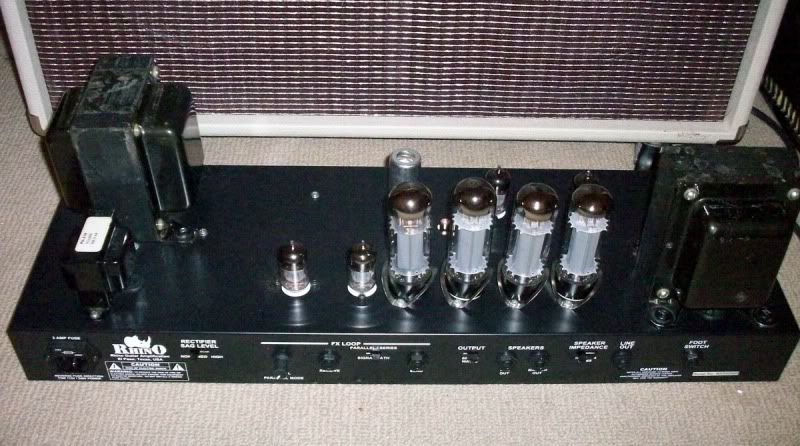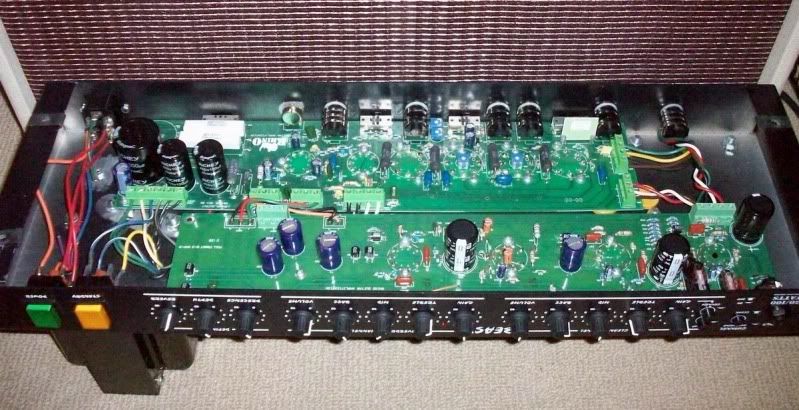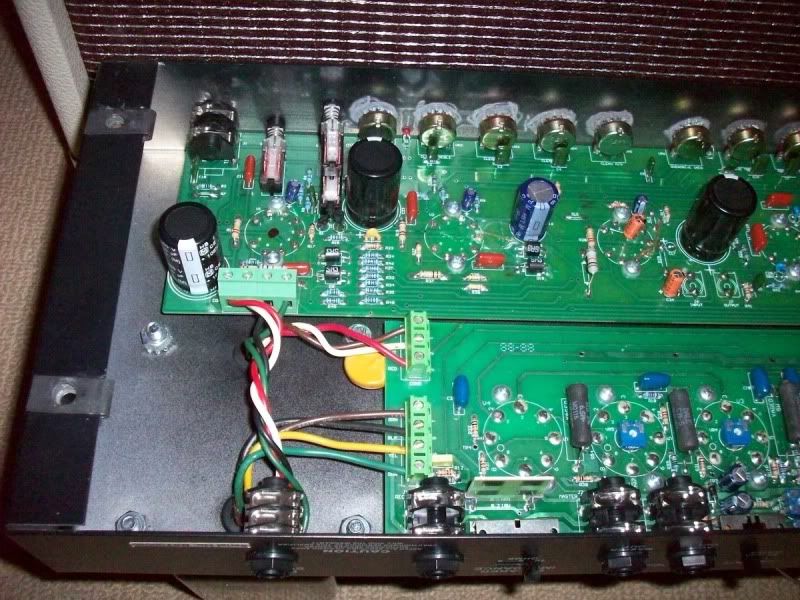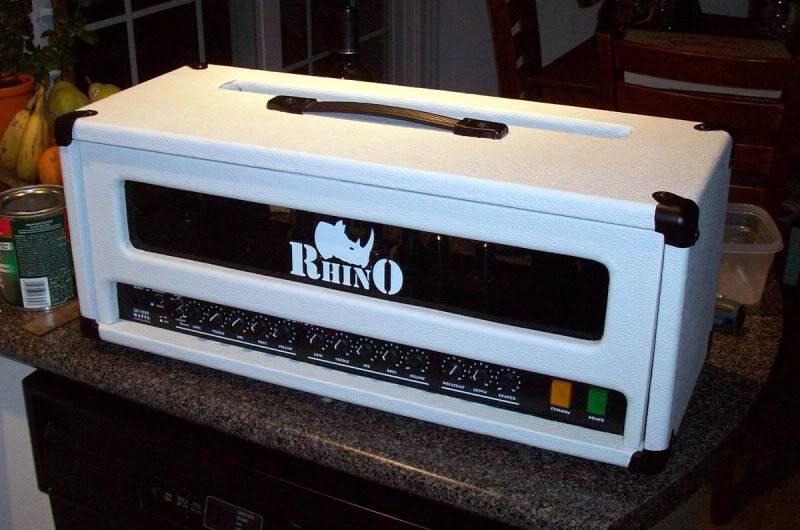I forgot to post this here, but I got this a couple of days ago.
My latest Ebay impulse buy arrived today at work. I hit Buy It Now for this thing purely out of curiosity, and my inherent desire to find bargains in defiance of others' advice. I had heard only negative about Rhino amps in general, but I figured for $199, it would probably be worth it for parts alone, or at the very least, I could re-sell it and recoup my losses easily. However, I was warned that the parts were almost certainly cheap junk, and that I had just wasted my money.


Upon getting this thing home, opening it up, and taking a look inside, it honestly looks as well made as any mass produced modern amplifier. The trannies are nice big chunks of iron, and look identical in size and shape to the Hammond JCM800 set I recently bought. While the pots and ceramic power tube sockets are board mounted, there doesn't seem to be anything obviously cheap or low quality about this amp. Sure, it's not boutique or mil-spec by any means, but these days, ya gotta spend big bucks for that kind of thing anyway. The one thing that they obviously skimped on (and they're not alone in this respect), is that the chassis is somewhat flimsy. My Slo-Clone chassis is 14 gauge steel with welded corners. This is how an amplifier chassis should be made. The Rhino chassis is 16 gauge steel, which would be fine, except has no welded corners. Without the welded corners, the chassis has a little too much flex IMO.

Anyway, I plugged in the amp, let it warm up for a minute or so, set all the EQ knobs to noon, the gain and volume right down, and turned it on. Running through a Lopo 2X12 loaded with English made V-30s, I tried the clean channel first, and I gotta say, it's pretty damn good. The BRIGHT and CRUNCH switches, make it very versatile, doing anything from a true clean, all the way up to a nice sparkling AC/DC crunch. This thing is actually very Marshall-like. In other words, it's not super clean, and breaks up quite easily.

The dirty channel was also a pleasant surprise. Starting at a pretty low gain level, with all the EQs at noon, this amp is pretty much a hot rodded 800 but with some tone stack changes that don't quite hit the mark. Running up through different gain levels, all the way to wide open high gain, it is immediately obvious that it has far too much bottom end for higher volume levels. It seems like they attempted to make a 100 watt Marshall that could be used as a low volume bedroom amp. Pretty silly really. However, having said that, backing off on the low end a little, and adding some mids makes a huge difference. The gain structure is very aggressive, and reminds me a lot of a Fortin Bones I heard recently. It took barely any time at all for me to dial in a useable tone. Curious about how it would take to a boost, I plugged in a Boss SD-1, level cranked, drive at zero, and tone at 9 o'clock. WOW! The nay-sayers aren't going to believe me until I can back it up with a decent clip, but this thing really is a Beast. I was able to cop a convincing Zakk Wylde Blessed Hellride tone. I also briefly tried a Boss EQ in the loop, which is switchable from parallel (with a mix level control), to a series loop. I didn't try the parallel setting, but in series mode, the loop works well with the EQ pedal, and an ISP Decimator noise gate.

I'm looking forward to playing this at band practice tomorrow, to see how well it sits in the mix.
The Ebay seller told me there was a problem with the rectifier, and that it wouldn't switch from 50 to 100 watts. As it turns out, it switches between 50 and 100 watts no problem. The only issue the amp has is that it has a switch on the back with 3 sag settings: NONE, MEDIUM, AND HIGH, and the only setting that seems to function, is the NONE setting. I'm not very optimistic about finding a schematic for this amp, but I am going to do my best to track down the problem anyway. If I can't fix it, it's not really a big deal, as the NONE setting sounds great.
I recently purged myself of a Peavey Windsor that I picked up for around the same price as this, and I was glad to see it go. I bought it on a whim just like with this one, but that was based upon testimony from several people, that they actually sounded pretty good. A couple of years back, I also traded my B-52 AT-100 for a Laney Pro-Tube 50. Again, this was based largely upon the opinion of several people that they did the "hot-rodded Marshall" thing quite well. Both of those amps were a huge, and immediate disappointment. The Windsor sounds gritty and harsh, had tiny, cheapo transformers, and was generally pretty low quality. The Laney was built well enough, but sounded so bad, I took it to a tech immediately, thinking there was a problem. Other than repairing the effects loop (which was still pretty much useless) he said there was nothing at all wrong with it, and that they all sound that bad. I guess he doesn't like them either.
The bottom line is, barring any future reliability issues (which are an unknown with virtually any amp), I am very much not disappointed with this purchase. I'll do my best to get clips up this weekend.
My latest Ebay impulse buy arrived today at work. I hit Buy It Now for this thing purely out of curiosity, and my inherent desire to find bargains in defiance of others' advice. I had heard only negative about Rhino amps in general, but I figured for $199, it would probably be worth it for parts alone, or at the very least, I could re-sell it and recoup my losses easily. However, I was warned that the parts were almost certainly cheap junk, and that I had just wasted my money.


Upon getting this thing home, opening it up, and taking a look inside, it honestly looks as well made as any mass produced modern amplifier. The trannies are nice big chunks of iron, and look identical in size and shape to the Hammond JCM800 set I recently bought. While the pots and ceramic power tube sockets are board mounted, there doesn't seem to be anything obviously cheap or low quality about this amp. Sure, it's not boutique or mil-spec by any means, but these days, ya gotta spend big bucks for that kind of thing anyway. The one thing that they obviously skimped on (and they're not alone in this respect), is that the chassis is somewhat flimsy. My Slo-Clone chassis is 14 gauge steel with welded corners. This is how an amplifier chassis should be made. The Rhino chassis is 16 gauge steel, which would be fine, except has no welded corners. Without the welded corners, the chassis has a little too much flex IMO.

Anyway, I plugged in the amp, let it warm up for a minute or so, set all the EQ knobs to noon, the gain and volume right down, and turned it on. Running through a Lopo 2X12 loaded with English made V-30s, I tried the clean channel first, and I gotta say, it's pretty damn good. The BRIGHT and CRUNCH switches, make it very versatile, doing anything from a true clean, all the way up to a nice sparkling AC/DC crunch. This thing is actually very Marshall-like. In other words, it's not super clean, and breaks up quite easily.

The dirty channel was also a pleasant surprise. Starting at a pretty low gain level, with all the EQs at noon, this amp is pretty much a hot rodded 800 but with some tone stack changes that don't quite hit the mark. Running up through different gain levels, all the way to wide open high gain, it is immediately obvious that it has far too much bottom end for higher volume levels. It seems like they attempted to make a 100 watt Marshall that could be used as a low volume bedroom amp. Pretty silly really. However, having said that, backing off on the low end a little, and adding some mids makes a huge difference. The gain structure is very aggressive, and reminds me a lot of a Fortin Bones I heard recently. It took barely any time at all for me to dial in a useable tone. Curious about how it would take to a boost, I plugged in a Boss SD-1, level cranked, drive at zero, and tone at 9 o'clock. WOW! The nay-sayers aren't going to believe me until I can back it up with a decent clip, but this thing really is a Beast. I was able to cop a convincing Zakk Wylde Blessed Hellride tone. I also briefly tried a Boss EQ in the loop, which is switchable from parallel (with a mix level control), to a series loop. I didn't try the parallel setting, but in series mode, the loop works well with the EQ pedal, and an ISP Decimator noise gate.

I'm looking forward to playing this at band practice tomorrow, to see how well it sits in the mix.
The Ebay seller told me there was a problem with the rectifier, and that it wouldn't switch from 50 to 100 watts. As it turns out, it switches between 50 and 100 watts no problem. The only issue the amp has is that it has a switch on the back with 3 sag settings: NONE, MEDIUM, AND HIGH, and the only setting that seems to function, is the NONE setting. I'm not very optimistic about finding a schematic for this amp, but I am going to do my best to track down the problem anyway. If I can't fix it, it's not really a big deal, as the NONE setting sounds great.
I recently purged myself of a Peavey Windsor that I picked up for around the same price as this, and I was glad to see it go. I bought it on a whim just like with this one, but that was based upon testimony from several people, that they actually sounded pretty good. A couple of years back, I also traded my B-52 AT-100 for a Laney Pro-Tube 50. Again, this was based largely upon the opinion of several people that they did the "hot-rodded Marshall" thing quite well. Both of those amps were a huge, and immediate disappointment. The Windsor sounds gritty and harsh, had tiny, cheapo transformers, and was generally pretty low quality. The Laney was built well enough, but sounded so bad, I took it to a tech immediately, thinking there was a problem. Other than repairing the effects loop (which was still pretty much useless) he said there was nothing at all wrong with it, and that they all sound that bad. I guess he doesn't like them either.

The bottom line is, barring any future reliability issues (which are an unknown with virtually any amp), I am very much not disappointed with this purchase. I'll do my best to get clips up this weekend.


Comment